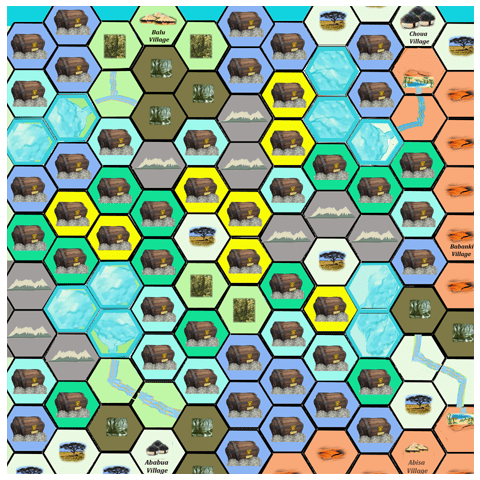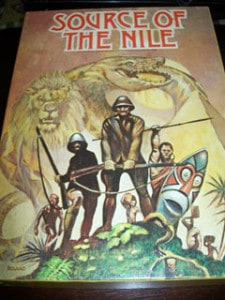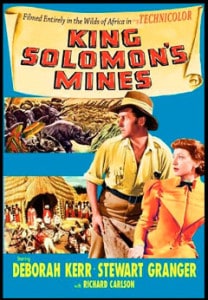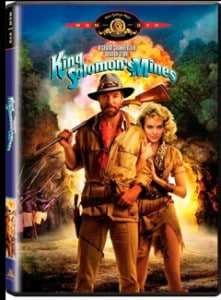
At the end of my recent article “Is “Reboot” Alive in Board Game Design?“, I mentioned a current design project on my table, which is inspired by an Avalon Hill out-of-print game called The Source of the Nile, from 1978.

The project is also influenced by King Solomon’s Mines (1885) a popular novel by the Victorian adventure writer Sir H.Rider Haggard, which was rebooted as a film in 1950, and again in 1985.
1950  1985
1985 
The following are some of the design challenges I’ve faced on this soft-reboot design. Like many of the Avalon Hill games of that period, the length of game play and complexity don’t fare well in the current board game market.
GAME EXPERIENCES TO RETAIN
Drawing from The Source of the Nile, I wanted to retain the excitement of exploring Africa in the 1800’s and the tension & apprehension of discovering African tribes. I decided to make change the main objective to finding the Mines of King Solomon. Also, to meet modern gamers’ expectations I’d build the game to have a more reasonable game length: 60 to 90 minutes. This would require reducing the number of unknown hexes on the board, and the mechanics would need to be simplified.
EXPLORATION OF THE UNKNOWN BY HEXES
The game board of The Source of the Nile was almost entirely unknown blank hexes on which the players using crayons would draw in the terrain topography as discovered through Event cards.
In an attempt to retain as much of the original game’s use of hexes the first board I built consisted of only individual terrain hexes in four levels, randomly selected and placed in the playing area to construct the game board on the fly.
This game board would consists only of sixty hex tiles. It was almost immediately evident this would not work even before producing a prototype version. The terrain sides of the hexes with restrictions as to what kind of terrain could align to a terrain side would take way too much time and not be that much fun. Back to the drawing board.
The next game board had more known hexes but still consisted of 110 hexes of which 46 were unknown randomly placed hex tiles. The game still took too long to play and it was too difficult to develop a strategy.
Here’s the current game board which reduced the random terrain hexes to 9 and simplified their impact on the game scoring. Players each start play at a village of their choice, selected in reverse turn order, along the edges of the board. The village in the center of the game board is not a valid starting point. More scoring hexes are visible, improving the the ability to craft strategies from the beginning of the game.
CHALLENGES OF TRIBES
I wanted to retain the unknown tribal attitude of discovered Africans – peaceful or hostile. My original version had players allocating Resource Points to build their safaris. This allowed for safari Armed Bearers in engagements with either hostile or peaceful tribes. Early feed back highlighted complexity which would be added to the game in forming safaris and this approach was dropped.
I needed to reduce the interaction with tribes and simplify trading and fighting which were featured in The Source of the Nile with its numerous charts.

So, interactions with tribes were included in the Events card that a player would randomly draw each round. The results were determined by the attitude of the Tribe, its number of Warriors, if hostile, or the number of villagers, if trading was to occur, versus the safari’s Armed Bearers & Guide’s Conflict rating.

In an attempt to continue reducing play time and complexity, not only was the building of safaris eliminated but the Event cards needed simplification, resulting in them becoming Action cards with fewer elements on each card.

These Action cards had 3 choices of action of which only 1 choice could be used.
Tribal interaction was given their own randomly selected cards which merely awarded or debited victory points. These Tribal cards are obtained by finding random unknown hexes with a tribe icon on the tile.


Further simplification in the Action cards and a change in the Tribe cards & their function brings us to the current version of the prototype.


The Tribe cards are no longer straight Victory Points but rather rumors & information on which kind of terrain a player’s Primary Goal as well as the King Solomon’s mines are located. The most recent play tests have moved me to conclude that the core game mechanics are solid and to move on to further play testing for balance and tweaking. The challenges to modify a simulation game design to a more modern design have presented many challenges, but the gaming experience of the old Avalon Hill game is worth rebooting.
HAVE YOU MODIFIED A SIMULATION GAME DESIGN TO A EURO? COMMENT BELOW, PLEASE!













